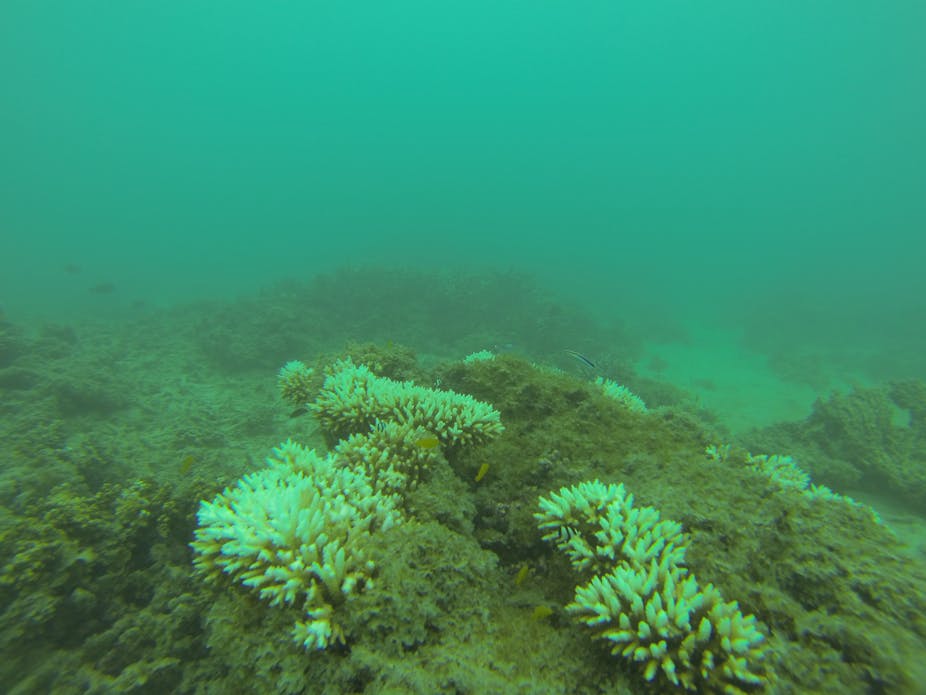The latest healthcheck of the Great Barrier Reef shows the overall outlook is “poor”, and getting worse. According to the Outlook Report produced by the Great Barrier Reef Marine Park Authority, climate change is still the greatest threat to the reef. Other threats include runoff, dredging, incidental bycatch and illegal fishing.
The report contains confronting evidence of a 50% loss of corals, another major outbreak of crown-of-thorns starfish, further declines or no recovery in most species of large wildlife, and ongoing impacts of fishing.
Remarkably, despite all the clear evidence for the declining condition of the Barrier Reef region, the report concludes that its outstanding heritage values remain intact and that sediment runoff from agriculture has been reduced.
Reef condition is declining
Initial reaction to the report has been very mixed. Environment Minister Greg Hunt concluded, despite all of the scientific evidence compiled in the report, that the Great Barrier Reef remains one of the “most resilient marine ecosystems in the world”
Other commentators state that reports on the condition of the reef cherry-pick optimistic vignettes (such as the recovery of humpback whales since the end of harvesting in Antarctica), while claiming insufficient information exists on widespread problems such as impacts of dredging, poaching and incidental bycatch of sharks, dugongs, sea snakes and many other species.
The report conveniently places a lot of blame on the recent weather — for a new outbreak of crown-of-thorns starfish and for the slow decline of corals, seagrasses and dugong.
In reality, the causes of decline are much more complex and longer-term. They can’t simply be attributed a few recent storms, while ignoring ongoing flaws in governance and management.
For example, unsustainable harvesting, drowning in nets and collisions with ships have all contributed to the 97% decline in dugongs in the central and southern sections of the marine park. None of these issues is being adequately addressed. Similarly, attempts to cull crown-of-thorns starfish by lethal injection miss the point that the root cause of the outbreaks is poorly regulated runoff of nutrients.
Runoff remains a key issue
The report states optimistically that pollution loads entering the reef have been measurably reduced by changes in land use, funded by the Commonwealth, the Queensland state and by farmers.
However, the only evidence to support this claim is an unpublished model from CSIRO. The model predicts that runoff or sediments and nutrients may eventually be about 10% lower. This prediction may well be true, but it will take decades to verify.
Although the report doesn’t say so, if dumping of unprecedented amounts of dredge spoil continues to be allowed within the marine park, it will easily swamp all of the modest predicted improvement in runoff of sediments from land.
Consequently, the most cost-effective measure to improve sediment loads would be to ban dumping of dredge spoil at sea. Implementation of the Queensland Ports Strategy for developing coal exports would lead to a vast acceleration in CO2 emissions if coal deposits are developed, unprecedented port expansion along the coast, dredging and dumping, and inevitable loss of World Heritage values.
Shift away from protecting the reef
The report continues an evolving discourse on how the Great Barrier Reef is governed and managed. The 1975 Marine Park Act states that the overarching objective of the Commonwealth is to protect and conserve the Great Barrier Reef Region. Today, the focus is less on protection and more on management of multiple uses, including plans for some of the world’s largest coal ports.
The original large-scale emphasis on protection of the whole region has also faded. The outlook report argues that the likely impacts of dredging near Cairns, Townsville, Bowen, Mackay and Gladstone are quite localised and occur in areas that are “already under pressure”. The inference is that they are therefore acceptable.
Similarly, the growing use of environmental offsets to allow unprecedented levels of dredging and coastal development is effectively an abandonment of early commitments by the Commonwealth to protect all of the Great Barrier Reef Region. This has led to UNESCO’s concerns over poor governance and the declining “integrity” or wholeness of the World Heritage Area.
The outlook report emphasises how the north section of the marine park is in still good condition, while the central and southern regions south of Cooktown are slowly degrading. Many people would view this as a failure to live up to the spirit of the 1975 Act.
Cuts to funding
The outlook report highlights the need for better protection of the Great Barrier Reef, yet the budget for the Great Barrier Reef Marine Park Authority has been wound back. The agency is losing key staff.
Queensland has also wound back financial support for fisheries management, axed the independent fishery observer program and sacked staff. In 2012-13, Fisheries Queensland had a budget cut of more than A$4 million and lost 60 positions.
Arguably, the biggest risks to the Great Barrier Reef World Heritage Area are: a) destructive government policies such as removal of “green tape” and the implementation of offsets that allow new developments to proceed despite the environmental damage they cause; b) the demonstrable failure of the state and Commonwealth to tackle climate change; and c) the ongoing conflicts of interest over mining royalties received by the Commonwealth and state of Queensland versus their responsibilities for stewardship of the Great Barrier Reef.

